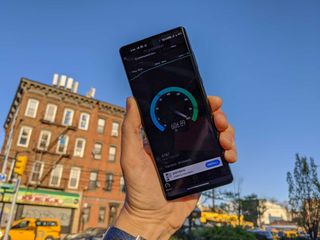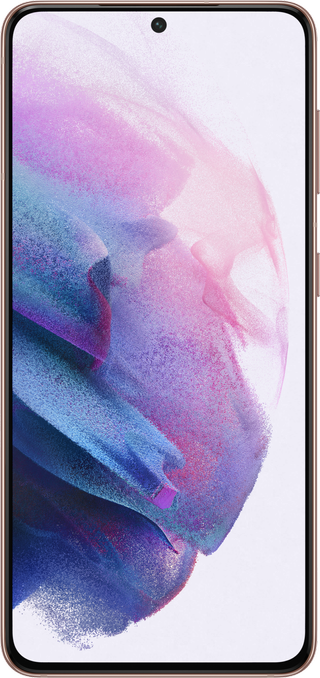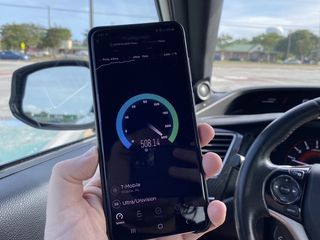6 reasons not to get 5G service in 2022

5G now covers most people in the U.S. on at least one carrier, but there are many reasons why 5G isn't worth it for many people. There is also a lot of potential for savings if you buy an LTE-only phone like the Pixel 4a, and you may not be willing to upgrade your old phone plan just for 5G. For many people, LTE is more than fast enough, and its coverage area is still bigger than 5G, especially on AT&T and Verizon.

Sub-6 and mmWave support for every carrier
The Galaxy S21 is the perfect companion to a 5G network with great support for sub-6 and mmWave 5G with timely security updates.
Coverage on AT&T and Verizon
If you live in a suburban or urban area, there's a good chance you have 5G coverage from at least one carrier— probably T-Mobile. AT&T and Verizon are making big investments in 5G, but their heavy reliance on C-band and mmWave means they're a distant second and third in coverage and will stay there well into 2022.
AT&T and Verizon are working fast to expand their nationwide 5G networks on low-band spectrum and shared spectrum, but it's far from a complete 5G network. Coverage is fairly similar across the three carriers in major cities, but when you head out to the suburbs or rural areas, coverage falls off very quickly.

If you're willing to switch to T-Mobile or one of the MVNOs that uses its network, you'll likely get a solid 5G signal even in many rural areas. This is thanks to T-Mobile's band n71 spectrum, called Extended Range 5G, which now covers more than 300 million people. Extended Range 5G is great except for its speed, which looks very similar to LTE most of the time.
The big speed upgrades aren't here for most of us
The biggest promise of 5G is greater download and upload speeds even when the network is congested. This is pulled off mostly thanks to the large chunks of spectrum available to 5G in the mid-band and high-band frequencies. The highest frequencies called mmWave (millimeter wave) are the fastest, with speeds over 1Gbps, but coverage is extremely weak. For an airport, convention center, or stadium, mmWave makes a lot of sense, but not so much outside.
Mid-band spectrum is the compromise between the low-band 5G options and mmWave. This includes T-Mobile's 2.5GHz spectrum as well as C-band spectrum. The major difference between the two is that T-Mobile has had access to 2.5GHz spectrum since it completed its purchase of Sprint in April of 2020, while AT&T and Verizon need to wait for C-band later in 2021. This has given T-Mobile a commanding lead with more than 150 million people already covered.
Mid-band spectrum will increase download speeds to the range of 300Mbps to 1Gbps though many aren't covered by T-Mobile yet, and AT&T and Verizon must wait patiently before they can deploy their new tech.
Be an expert in 5 minutes
Get the latest news from Android Central, your trusted companion in the world of Android

5G still isn't fully cooked
5G started out mainly as mmWave with its impressive download speeds of around 1Gbps in many places. The first wave of 5G phones only supported mmWave and still have very limited 5G coverage. The introduction of low-band 5G phones on T-Mobile had a similar issue, with many only supporting the slower Extended Range 5G network. It wasn't until the Galaxy S21 series that mmWave and sub-6 5G were both included across the entire range. For example, the Galaxy S20 didn't support mmWave while the Plus and Ultra variants did.
While newer flagship phones support most or all of the currently needed bands for 5G, these can be quite expensive. Even if you opted for the high-end Galaxy S20 plus last year, you wouldn't get support for C-band. This isn't a huge deal for most people, but if you want to get the most out of 5G, you still need to buy the most expensive phones. Beyond that, there's still no telling exactly how long it will take carriers to build out their C-band networks.
You're old plan might be cheaper

The best cell phone plans you can get today support 5G, but that doesn't mean your old plan does. T-Mobile has expanded 5G to all of its customers regardless of plans in a move that every carrier should follow. However, there are still a lot of AT&T and Verizon customers artificially limited to LTE.
Cricket is one of the most popular prepaid carriers, and it only supports 5G on its most expensive unlimited plan. While Verizon has expanded the use of its nationwide 5G network to most of its plans, its mmWave Ultra Wideband network is only available on its most expensive unlimited plans. This is at odds with the core goals of mmWave, which is supposed to be able to easily handle massive amounts of traffic.
Many people are happy with their old phone plans on Verizon or AT&T and don't want to switch to a new plan. Most of these people won't get 5G access on their plans, making the upgrade to a 5G phone a bit of a waste. If you live in a rural area with poor coverage, for example, there are even fewer reasons to upgrade since, optimistically, you likely won't even see 5G coverage for more than a year at your home.
More phones

Most new phones, including mid-range options like the OnePlus Nord N200, support 5G now, but there are still many cheap phones that don't. So if you're looking to save some money on your phone, leaving out 5G is a good way to save. Since nearly all phones support LTE, you can still get more than enough speed to stream and browse.
With 5G phones being more than capable of connecting to 4G and the ability to disable 5G in the settings if coverage is spotty, upgrading to something like the Samsung Galaxy S21 will ensure you have support for 5G when it arrives while also supporting the full range of LTE bands.
You will still use a lot of LTE
No matter which carrier you're on, you're still going to find a lot of places where you drop back down to LTE, even if your phone still says 5G. While LTE is fast enough for most of what people do on their phones, paying for 5G capabilities only to spend a lot of time on 4G LTE can feel like a waste. With time, 5G coverage will more than likely come to cover the entire footprint of any LTE network; it's not here just yet.

Sub-6 and mmWave support for every carrier
The Galaxy S21 is the perfect companion to a 5G network with great support for sub-6 and mmWave 5G with timely security updates.
It's time for most people to move to 5G
AT&T, T-Mobile, and Verizon are each surpassing 5G milestones regularly, with T-Mobile achieving 300 million people covered in June of 2021. Not only that, but mid-band coverage, including C-band, will be kicking into high gear as the spectrum becomes available later in 2021 and 2022. While it's not a good enough reason to upgrade your phone early, if you're ready for a great new Android phone, you should get one with 5G support. 5G is now more accessible than ever thanks to continued investment from carriers, and we've recounted seven reasons to join in.
When Samuel is not writing about networking or 5G at Android Central, he spends most of his time researching computer components and obsessing over what CPU goes into the ultimate Windows 98 computer. It's the Pentium 3.

